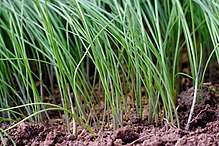Allium monanthum
Allium monanthum, the Korean wild chive,[2] is a spring vegetable with minuscule bulbous roots that have a mild onion flavor and found in the woodlands of Korea, Japan, northeastern Russia (Primorye), and northeastern China (Hebei, Heilongjiang, Jilin, Liaoning).[3][4][5][6][7]
| Korean wild chive | |
|---|---|
 | |
| Korean wild chive in Seosan, Korea | |
| Scientific classification | |
| Kingdom: | Plantae |
| Clade: | Tracheophytes |
| Clade: | Angiosperms |
| Clade: | Monocots |
| Order: | Asparagales |
| Family: | Amaryllidaceae |
| Subfamily: | Allioideae |
| Genus: | Allium |
| Species: | A. monanthum |
| Binomial name | |
| Allium monanthum Maxim. | |
| Synonyms[1] | |
| |
Description
Allium monanthum is unusual in the genus in being usually dioecious (male and female flowers on separate plants), but rarely hermaphrodite or gynomonoecious.[8] The species produces a single round bulb about 1 cm (1⁄3 in) in diameter. Scapes are relatively short for the genus, rarely more than 10 cm (4 in) tall. Leaves are flat, long and narrow, longer than the scape. Umbels are small, with one flower on pistillate (female) plants and 4-5 flowers on staminate (male) plants. All flowers are white, pink or red.[3][9][10][11]
 Roots, bulbs, stalks, and leaves
Roots, bulbs, stalks, and leaves
Culinary uses
Korea
Called dallae (달래) in Korean, Korean wild chives are used in Korean herbal cooking alongside other san-namul (mountain vegetables) such as deodeok, angelica-tree, gondre and Siberian onion. Having a similar flavor profile to Tree onion, Korean wild chives can be eaten raw or blanched as a namul (seasoned herbal vegetable dish), pickled as a jangajji, or pan-fried to make buchimgae (pancake). As a herb, Korean wild chives make a good last minute addition to doenjang-jjigae (soybean paste stew) and other jjigae (stews). Soy sauce based dips are often flavored with Korean wild chives. In North Korea, radish water kimchi flavored with Korean wild chives is a popular spring banchan (side dish).[12]
.jpg) Dallae-muchim (seasoned wild chives) on samgyeopsal (grilled pork belly)
Dallae-muchim (seasoned wild chives) on samgyeopsal (grilled pork belly) Dallae-bulgogi (bulgogi with wild chives)
Dallae-bulgogi (bulgogi with wild chives) Dallae-doenjang-guk (soybean paste soup with wild chives)
Dallae-doenjang-guk (soybean paste soup with wild chives)
References
- The Plant List
- English Names for Korean Native Plants (PDF). Pocheon: Korea National Arboretum. 2015. p. 347. ISBN 978-89-97450-98-5. Archived from the original (PDF) on 25 May 2017. Retrieved 6 December 2016 – via Korea Forest Service.
- Flora of China v 24 p 202. big>单花薤
dan hua xie Allium monanthum - Ohwi, J. (1984). Flora of Japan (in English): 1-1067. Smithsonian Institution, Washington, D.C..
- Kharkevich, S.S. (ed.) (1987). Plantae Vasculares Orientalis Extremi Sovietici 2: 1-448. Nauka, Leningrad.
- Denisov, N. (2008). Addition to Vascular flora of the Kozlov island (Peter the Great Gulf, Japanese sea). Turczaninowia 11(4): 29-42.
- Choi, H.J. & Oh, B.U. (2011). A partial revision of Allium (Amaryllidaceae) in Korea and north-eastern China. Botanical Journal of the Linnean Society 167: 153-211.
- Noda, Shozo; Kawano, Shoichi (1988-06-01). "The Biology of Allium monanthum (Liliaceae) I. Polyploid Complex and Variations in Karyotype". Plant Species Biology. 3 (1): 13–26. doi:10.1111/j.1442-1984.1988.tb00167.x. ISSN 1442-1984.
- Maximowicz, Carl Johann. 1886.Bulletin de l'Academie Imperiale des Sciences de St-Petersbourg 31(1): 109.
- line drawing of Allium monanthum, Flora of China Illustrations vol. 24, fig.234, 1-5.
- Zhong, Zhan-jiang, & Huang, Xiang-tong. 1997. Bulletin of Botanical Research. Harbin 17(1): 53.
- Unification Media Group (25 March 2016). "To overcome 'barley hump', necessity is the mother of invention [As Heard in North Korea]". DailyNK. Retrieved 18 December 2016.
.jpg)